Observing Solids as a Flat copy.
As it is only from one point of view that things can be drawn, and as we have two eyes, therefore two points of view, the closing of one eye will be helpful at first.
The simplest and most mechanical way of observing things as a flat subject is to have a piece of cardboard with a rectangular hole cut out of the middle, and also pieces of cotton threaded through it in such a manner that they make a pattern of squares across the opening, as in the accompanying sketch. To make such a frame, get a piece of stiff cardboard, about 12 inches by 9 inches, and cut a rectangular hole in the centre, 7 inches by 5 inches, as in Diagram III. Now mark off the inches on 85all sides of the opening, and taking some black thread, pass it through the point A with a needle (fixing the end at this point with sealing-wax), and across the opening to the corresponding point on the opposite side. Take it along to the next point, as shown by the dotted line, and pass it through and across the opening again, and so on, until B is reached, when the thread should be held by some sealing-wax quite taut everywhere. Do the same for the other side. This frame should be held between the eye and the object to be drawn 86(one eye being closed) in a perfectly vertical position, and with the rectangular sides of the opening vertical and horizontal. The object can then be observed as a flat copy. The trellis of cotton will greatly help the student in seeing the subject to be drawn in two dimensions, and this is the first technical difficulty the young draughtsman has to overcome. It is useful also in training the eye to see the proportions of different parts one to another, the squares of equal size giving one a unit of measurement by which all parts can be scaled.
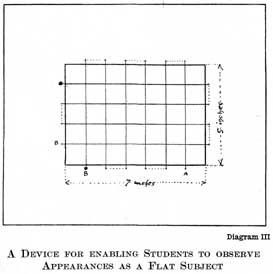
Diagram III.
A DEVICE FOR ENABLING STUDENTS TO OBSERVE APPEARANCES AS A FLAT SUBJECT
Fixing Positions of Salient Points
Vertical and horizontal lines are also of the utmost importance in that first consideration for setting out a drawing, namely the fixing of salient points, and getting their relative Positions. Fig. Z, on page 87 [Transcribers Note: Diagram IV], will illustrate what is meant. Let A B C D E be assumed to be points of some importance in an object you wish to draw. Unaided, the placing of these points would be a matter of considerable difficulty. But if you assume a vertical line drawn from A, the positions of B, C, D, and E can be observed in relation to it by noting the height and length of horizontal lines drawn from them to this vertical line. This vertical can be drawn by holding a plumb line at arm's length (closing one eye, of course) and bringing it to a position where it will cover the point A on your subject. The position of the other points on either side of this vertical line can then be observed. Or a knitting-needle can be held vertically before you at arm's length, giving you a line passing through point A. The advantage of the needle is that comparative measurements can be taken with it.
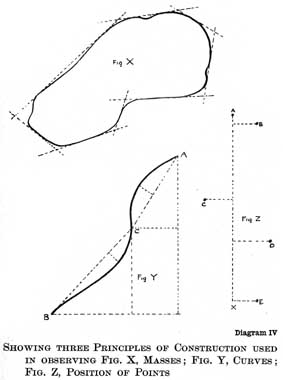
Diagram IV.
SHOWING THREE PRINCIPLES OF CONSTRUCTION USED IN OBSERVING FIG. X, MASSES; FIG. Y, CURVES; FIG. Z, POSITION OF POINTS
88In measuring comparative distances the needle should always be held at arm's length and the eye kept in one position during the operation; and, whether held vertically or horizontally, always kept in a vertical plane, that is, either straight up and down, or across at right angles to the line of your vision. If these things are not carefully observed, your comparisons will not be true. The method employed is to run the thumb-nail up the needle until the distance from the point so reached to the top exactly corresponds with the distance on the object you wish to measure. Having this carefully noted on your needle, without moving the position of your eye, you can move your outstretched arm and compare it with other distances on the object. It is never advisable to compare other than vertical and horizontal measurements. In our diagram the points were drawn at random and do not come in any obvious mathematical relationship, and this is the usual circumstance in nature. But point C will be found to be a little above the half, and point D a little less than a third of the way up the vertical line. How much above the half and less than the third will have to be observed by eye and a corresponding amount allowed in setting out your drawing. In the horizontal distances, B will be found to be one-fourth the distance from X to the height of C on the right of our vertical line, and C a little more than this distance to the left, while the distance on the right of D is a little less than one-fifth of the whole height. The height of B is so near the top as to be best judged by eye, and its distance to the right is the same as B. These measurements are never to be taken as absolutely accurate, but are a great help to beginners in training 89 the eye, and are at times useful in every artist's work.
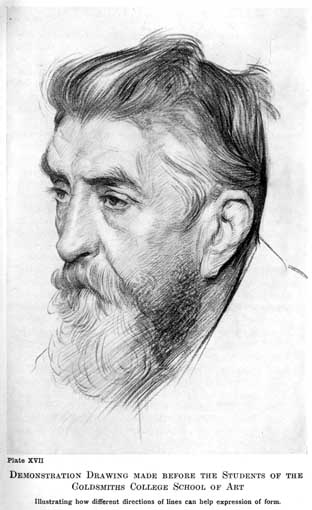
Plate XVII.
DEMONSTRATION DRAWING MADE BEFORE THE STUDENTS OF THE GOLDSMITHS COLLEGE SCHOOL OF ART
Illustrating how different directions of lines can help expression of form.
It is useful if one can establish a unit of measurement, some conspicuous distance that does not vary in the object (if a living model a great many distances will be constantly varying), and with which all distances can be compared.
In setting out a drawing, this fixing of certain salient points is the first thing for the student to do. The drawing reproduced on page 90 [Transcribers Note: Plate XVIII] has been made to illustrate the method of procedure it is advisable to adopt in training the eye to accurate observation. It was felt that a vertical line drawn through the pit of the arm would be the most useful for taking measurements on, and this was first drawn and its length decided upon. Train yourself to draw between limits decided upon at the start. This power will be of great use to you when you wish to place a figure in an exact position in a picture. The next thing to do is to get the relative heights of different points marked upon this line. The fold at the pit of the stomach was found to be exactly in the centre. This was a useful start, and it is generally advisable to note where the half comes first, and very useful if it comes in some obvious place. Other measurements were taken in the same way as our points A B C D E in the diagram on page 87 [Transcribers Note: Diagram IV], and horizontal lines drawn across, and the transverse distances measured in relation to the heights. I have left these lines on the drawing, and also different parts of it unfinished, so as to show the different stages of the work. These guide lines are done mentally later on, when the student is more advanced, and with more accuracy than the clumsy knitting-needle. 90But before the habit of having constantly in mind a vertical and horizontal line with which to compare positions is acquired, they should be put in with as much accuracy as measuring can give.
Blocking in your Drawing.
The next thing to do is to block out the spaces corresponding to those occupied by the model in the field of your vision. The method employed to do this is somewhat similar to that adopted by a surveyor in drawing the plan of a field. Assuming he had an irregular shaped one, such as is drawn in Fig. X, page 87 [Transcribers Note: Diagram IV], he would proceed to invest it with straight lines, taking advantage of any straightness in the boundary, noting the length and the angles at which these straight lines cut each other, and then reproducing them to scale on his plan. Once having got this scaffolding accurately placed, he can draw the irregularities of the shape in relation to these lines with some certainty of getting them right.
You should proceed in very much the same way to block out the spaces that the forms of your drawing are to occupy. I have produced these blocking-out lines beyond what was necessary in the accompanying drawing (page 87 [Transcribers Note: Diagram IV]), in order to show them more clearly.
How to observe the Shape of Curves.
There is yet another method of construction useful in noting accurately the shape of a curved line, which is illustrated in Fig. Y, page 87 [Transcribers Note: Diagram IV]. First of all, fix the positions of the extremities of the line by means of the vertical and horizontal. And also, as this is a double curve, the point at which the curvature changes from one direction to the other: point C. By drawing lines CA, CB and noting the distances 91your curves travel from these straight lines, and particularly the relative position of the farthest points reached, their curvature can be accurately observed and copied. In noting the varying curvature of forms, this construction should always be in your mind to enable you to observe them accurately. First note the points at which the curvature begins and ends, and then the distances it travels from a line joining these two points, holding up a pencil or knitting-needle against the model if need be.
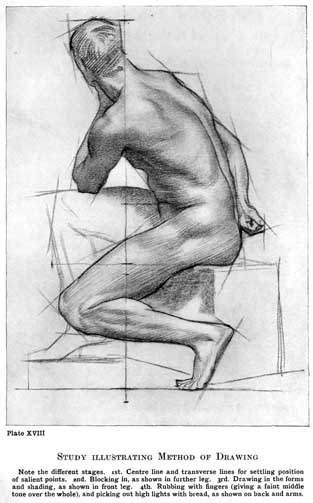
Plate XVIII.
STUDY ILLUSTRATING METHOD OF DRAWING
Note the different stages. 1st. Centre line and transverse lines for settling position of salient points. 2nd. Blocking in, as shown in further leg. 3rd. Drawing in the forms and shading, as shown in front leg. 4th. Rubbing with fingers (giving a faint middle tone over the whole), and picking out high lights with bread, as shown on back and arms.
The Drawing proper.
A drawing being blocked out in such a state as the further leg and foot of our demonstration drawing (page 90 [Transcribers Note: Plate XVIII]), it is time to begin the drawing proper. So far you have only been pegging out the ground it is going to occupy. This initial scaffolding, so necessary to train the eye, should be done as accurately as possible, but don't let it interfere with your freedom in expressing the forms afterwards. The work up to this point has been mechanical, but it is time to consider the subject with some feeling for form. Here knowledge of the structure of bones and muscles that underlie the skin will help you to seize on those things that are significant and express the form of the figure. And the student cannot do better than study the excellent book by Sir Alfred D. Fripp on this subject, entitled Human Anatomy for Art Students. Notice particularly the swing of the action, such things as the pull occasioned by the arm resting on the farther thigh, and the prominence given to the forms by the straining of the skin at the shoulder. Also the firm lines of the bent back and the crumpled forms of the front of the body. Notice the overlapping of the con92tours, and where they are accentuated and where more lost, &c., drawing with as much feeling and conviction as you are capable of. You will have for some time to work tentatively, feeling for the true shapes that you do not yet rightly see, but as soon as you feel any confidence, remember it should be your aim to express yourself freely and swiftly.
There is a tendency in some quarters to discourage this blocking in of the forms in straight lines, and certainly it has been harmful to the freedom of expression in the work of some students. They not only begin the drawing with this mechanical blocking in, but continue it in the same mechanical fashion, cutting up almost all their curves into flatnesses, and never once breaking free from this scaffolding to indulge in the enjoyment of free line expression. This, of course, is bad, and yet the character of a curved line is hardly to be accurately studied in any other way than by observing its relation to straight lines. The inclination and length of straight lines can be observed with certainty. But a curve has not this definiteness, and is a very unstable thing to set about copying unaided. Who but the highly skilled draughtsman could attempt to copy our random shape at Fig. X, page 87 [Transcribers Note: Diagram IV], without any guiding straight lines? And even the highly skilled draughtsman would draw such straight lines mentally. So that some blocking out of the curved forms, either done practically or in imagination, must be adopted to rightly observe any shapes. But do not forget that this is only a scaffolding, and should always be regarded as such and kicked away as soon as real form expression with any feeling begins.
93But it will be some years before the beginner has got his eye trained to such accuracy of observation that he can dispense with it.
In Blocking-in observe Shape of the Background as much as the Object.
In the case of foreshortenings, the eye, unaided by this blocking out, is always apt to be led astray. And here the observation of the shape of the background against the object will be of great assistance. The appearance of the foreshortened object is so unlike what you know it to be as a solid thing, that much as it is as well to concentrate the attention on the background rather than on the form in this blocking-out process. And in fact, in blocking out any object, whether foreshortened or not, the shape of the background should be observed as carefully as any other shape. But in making the drawing proper, the forms must be observed in their inner relations. That is to say, the lines bounding one side of a form must be observed in relation to the lines bounding the other side; as the true expression of form, which is the object of drawing, depends on the true relationship of these boundaries. The drawing of the two sides should be carried on simultaneously, so that one may constantly compare them.
Boundaries a series of Overlappings.
The boundaries of forms with any complexity, such as the human figure, are not continuous lines. One form overlaps another, like the lines of a range of hills. And this overlapping should be sought for and carefully expressed, the outlines being made up of a series of overlappings.
Shading.
In Line Drawing shading should only be used to aid the expression of form. It is not advisable to aim at representing the true tone values.
94In direct light it will be observed that a solid object has some portion of its surface in light, while other portions, those turned away from the light, are in shadow. Shadows are also cast on the ground and surrounding objects, called cast shadows. The parts of an object reflecting the most direct light are called the high lights. If the object have a shiny surface these lights are clear and distinct; if a dull surface, soft and diffused. In the case of a very shiny surface, such as a glazed pot, the light may be reflected so completely that a picture of the source of light, usually a window, will be seen.
In the diagram on page 95 [Transcribers Note: Diagram V], let A represent the plan of a cone, B C the opening of a window, and D the eye of the spectator, and E F G the wall of a room. Light travels in straight lines from the window, strikes the surface of the cone, and is reflected to the eye, making the angle of incidence equal to the angle of reflection, the angle of incidence being that made by the light striking an object, and the angle of reflection that made by the light in leaving the surface.
It will be seen that the lines B1D, C2D are the limits of the direct rays of light that come to the eye from the cone, and that therefore between points 1 and 2 will be seen the highest light. If the cone have a perfect reflecting surface, such as a looking-glass has, this would be all the direct light that would be reflected from the cone to the eye. But assuming it to have what is called a dull surface, light would be reflected from other parts also, although not in so great a quantity. If what is called a dull surface is looked at under a microscope it will be found to be quite rough, 96i.e. made up of many facets which catch light at different angles.
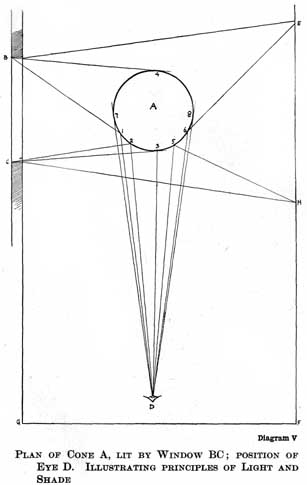
Diagram V.
PLAN OF CONE A, LIT BY WINDOW BC; POSITION OF EYE D. ILLUSTRATING PRINCIPLES OF LIGHT AND SHADE
Lines B4, C3 represent the extreme limits of light that can be received by the cone, and therefore at points 3 and 4 the shadow will commence. The fact that light is reflected to the eye right up to the point 3 does not upset the theory that it can only be reflected from points where the angle of incidence can equal the angle of reflection, as it would seem to do, because the surface being rough presents facets at different angles, from some of which it can be reflected to the eye right up to point 3. The number of these facets that can so reflect is naturally greatest near the high lights, and gets gradually less as the surface turns more away; until the point is reached where the shadows begin, at which point the surface positively turns away from the light and the reflection of direct light ceases altogether. After point 3 there would be no light coming to the eye from the object, were it not that it receives reflected light. Now, the greatest amount of reflected light will come from the direction opposite to that of the direct light, as all objects in this direction are strongly lit. The surface of the wall between points E and H, being directly opposite the light, will give most reflection. And between points 5 and 6 this light will be reflected by the cone to the eye in its greatest intensity, since at these points the angles of incidence equal the angles of reflection. The other parts of the shadow will receive a certain amount of reflected light, lessening in amount on either side of these points. We have now rays of light coming to the eye from the cone between the extreme points 7 and 8. From 7 to 3 we have 97the light, including the half tones. Between 1 and 2 the high light. Between 3 and 8 the shadows, with the greatest amount of reflected light between 5 and 6.
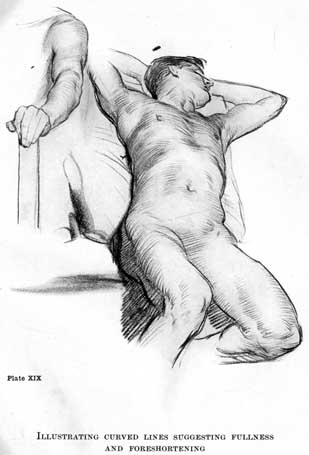
Plate XIX.
ILLUSTRATING CURVED LINKS SUGGESTING FULLNESS AND FORESHORTENING
I should not have troubled the reader with this tedious diagram were it not that certain facts about light and shade can be learned from it. The first is that the high lights come much more within the edge of the object than you would have expected. With the light directly opposite point 7, one might have thought the highest light would have come there, and that is where many students put it, until the loss of roundness in the appearance of their work makes them look more carefully for its position. So remember always to look out for high lights within the contours of forms, not on the edges.
The next thing to notice is that the darkest part of the shadow will come nearest the lights between points 3 and 5. This is the part tu............
